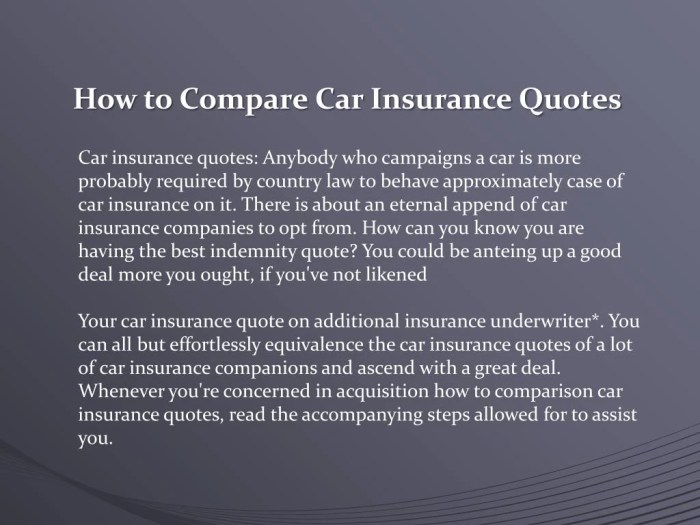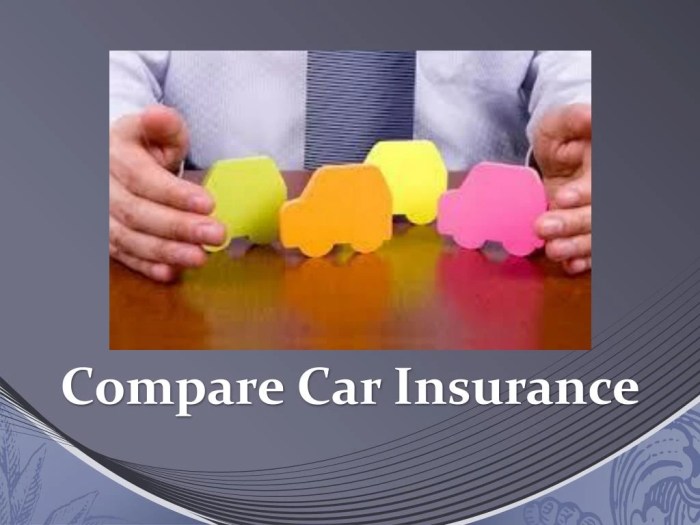How to compare car insurance quotes? This is a question that every car owner should ask themselves. After all, car insurance is a necessity, and finding the right policy can save you a lot of money in the long run.
But with so many different insurance companies and policies available, it can be overwhelming to know where to start.
This guide will walk you through the process of comparing car insurance quotes, from understanding your needs to choosing the right policy for you. We’ll cover everything you need to know to make an informed decision and get the best possible price on your car insurance.
Understanding Your Needs

Before diving into the world of car insurance quotes, it’s crucial to understand your individual needs. This will ensure you’re comparing apples to apples and getting the right coverage for your specific situation. Think of it like tailoring a suit – you wouldn’t wear a tuxedo to a casual picnic, right?
Factors Influencing Your Needs, How to compare car insurance quotes?
Several factors influence your car insurance needs. Here’s a breakdown of the key players:
- Driving History:Your driving record plays a significant role in determining your insurance premiums. A clean slate with no accidents or traffic violations translates into lower rates. Conversely, a history of accidents or tickets will likely lead to higher premiums.
- Car Type:The type of car you drive matters. Luxury cars, sports cars, and high-performance vehicles tend to have higher insurance premiums due to their higher repair costs and potential for greater damage in accidents.
- Location:Where you live influences your insurance rates. Areas with higher crime rates, traffic congestion, and a higher frequency of accidents generally have higher insurance premiums.
- Coverage Preferences:Your coverage preferences, like choosing a higher deductible or opting for specific coverage options, will directly impact your premium.
Determining Your Coverage Levels
It’s essential to determine the coverage levels you require. Consider these factors:
- Liability Coverage:This protects you financially if you’re responsible for an accident causing damage to another person’s property or injuries. It’s typically required by law, and the minimum coverage amounts vary by state.
- Collision Coverage:This covers damage to your car if you’re involved in an accident, regardless of who is at fault. It’s usually optional, and the deductible is the amount you pay out of pocket before the insurance kicks in.
- Comprehensive Coverage:This protects you against damage to your car caused by events other than accidents, such as theft, vandalism, or natural disasters. It’s often optional, and the deductible is the amount you pay out of pocket before the insurance kicks in.
Types of Car Insurance Coverage
Let’s delve into the different types of car insurance coverage available:
- Liability Coverage:This type of coverage protects you financially if you cause an accident that results in injuries or property damage to another person. It’s typically divided into two parts:
- Bodily Injury Liability:Covers medical expenses, lost wages, and other damages incurred by the injured party.
Comparing car insurance quotes can be a real head-scratcher, but don’t worry, you’re not alone! One thing to keep in mind is that if you have multiple cars, you might be able to save money with multi-car insurance quotes.
These special quotes take into account all your vehicles and could give you a better deal overall. So, before you settle on just one quote, see if you qualify for a multi-car discount and get the best deal for your driving needs!
- Property Damage Liability:Covers repairs or replacement costs for the other person’s vehicle or property.
- Bodily Injury Liability:Covers medical expenses, lost wages, and other damages incurred by the injured party.
- Collision Coverage:This coverage pays for repairs or replacement of your car if you’re involved in an accident, regardless of who is at fault. It’s optional and typically has a deductible, which is the amount you pay out of pocket before the insurance kicks in.
- Comprehensive Coverage:This coverage protects you against damage to your car caused by events other than accidents, such as theft, vandalism, fire, hail, or other natural disasters. It’s optional and typically has a deductible, which is the amount you pay out of pocket before the insurance kicks in.
- Uninsured/Underinsured Motorist Coverage:This coverage protects you if you’re involved in an accident with a driver who doesn’t have insurance or has insufficient coverage. It can help cover your medical expenses, lost wages, and other damages.
- Personal Injury Protection (PIP):This coverage covers your medical expenses, lost wages, and other damages if you’re injured in an accident, regardless of who is at fault. It’s often required by law in certain states.
- Medical Payments Coverage (Med Pay):This coverage pays for medical expenses for you and your passengers, regardless of who is at fault. It’s typically a smaller amount of coverage than PIP.
- Rental Reimbursement:This coverage helps pay for a rental car if your car is damaged and needs repairs.
- Roadside Assistance:This coverage provides assistance in case of a breakdown, flat tire, or other roadside emergencies.
Gathering Quotes
Now that you understand your insurance needs, it’s time to start gathering quotes. You can do this through various sources, each with its pros and cons. Let’s explore these options.
Sources for Car Insurance Quotes
Finding the best car insurance quotes involves exploring different sources. This ensures you compare various options and secure the most competitive coverage.
- Online comparison websites: These platforms allow you to enter your details once and receive quotes from multiple insurers simultaneously. This streamlines the process and saves you time.
- Insurance brokers: These professionals act as intermediaries, connecting you with different insurance companies. They can offer personalized advice and help you find the best policy based on your specific needs.
- Individual insurance companies: You can directly contact insurance companies and request quotes. This allows you to explore their specific offerings and build a relationship with a particular insurer.
Comparing Sources
Each source has its advantages and disadvantages, so it’s crucial to weigh them carefully:
| Source | Pros | Cons |
|---|---|---|
| Online comparison websites |
|
|
| Insurance brokers |
|
|
| Individual insurance companies |
|
|
The Importance of Using Multiple Sources
It’s crucial to gather quotes from multiple sources to ensure you have a comprehensive comparison. This allows you to:
- Identify the most competitive rates: Comparing quotes from different providers helps you find the best value for your money.
- Discover hidden gems: Some smaller insurers may offer competitive rates that aren’t readily available on comparison websites.
- Gain a deeper understanding of coverage options: Exploring different insurers’ offerings provides a broader perspective on available coverage and pricing.
Comparing Quotes
Now that you have a collection of car insurance quotes, it’s time to put on your detective hat and start comparing! This is where you’ll find the best value for your money. Don’t just go for the lowest price; consider the coverage and other factors that matter to you.
Key Factors to Compare
The following table provides a clear overview of the essential factors to consider when comparing car insurance quotes:| Factor | Description | Importance ||—|—|—|| Coverage| The types of protection included in your policy, such as liability, collision, comprehensive, and uninsured motorist coverage.
| This determines what your insurer will cover in case of an accident or damage to your vehicle. || Deductibles| The amount you pay out of pocket before your insurance kicks in for covered events. | A higher deductible typically means a lower premium, but you’ll pay more if you need to file a claim.
|| Premiums| The monthly or annual cost of your insurance policy. | This is the primary factor for most people, but it’s important to balance cost with coverage. || Discounts| Potential reductions in your premium based on factors like safe driving, good credit, multiple vehicles insured, or safety features in your car.
| Discounts can significantly lower your overall cost. || Customer Service| The responsiveness, helpfulness, and overall experience you have with your insurance company. | Good customer service is crucial, especially if you need to file a claim or have a question.
|
Analyzing and Comparing Quotes
Here’s a step-by-step guide to help you analyze and compare the quotes you’ve received:
- Review Coverage:Start by comparing the coverage levels offered by each insurer. Make sure all quotes include the minimum coverage required by your state and any additional coverage you need, like collision or comprehensive.
- Compare Deductibles:Analyze the deductibles offered for each coverage type. Consider your risk tolerance and financial situation when choosing a deductible. A higher deductible may be a good option if you’re comfortable paying more out of pocket in case of an accident.
- Calculate Premiums:Compare the total annual premium for each quote, factoring in any discounts you qualify for. Don’t just focus on the lowest premium; consider the overall value you’re getting for your money.
- Evaluate Customer Service:Check out online reviews and ratings for each insurance company. Look for reviews that mention customer service experiences, especially during claims processes.
- Consider the Fine Print:Carefully review the policy documents to understand the terms and conditions, exclusions, and any limitations on coverage.
Interpreting Different Quote Structures
Insurance quotes can be presented in different formats. Here are some common examples:
Example 1: Insurer A:Annual premium: $1,200 with a $500 deductible for collision and comprehensive coverage. Insurer B:Annual premium: $1,000 with a $1,000 deductible for collision and comprehensive coverage.
In this example, Insurer B offers a lower premium, but you’ll have to pay a higher deductible in case of an accident. Consider your financial situation and risk tolerance to decide which option is best for you.
Example 2:Insurer C:Annual premium: $1,100 with a $500 deductible for collision and a $1,000 deductible for comprehensive coverage. Insurer D:Annual premium: $1,150 with a $500 deductible for both collision and comprehensive coverage.
Here, Insurer D offers a slightly higher premium, but you’ll have the same deductible for both collision and comprehensive coverage, potentially simplifying your financial planning.
Choosing the Right Policy

You’ve compared quotes, and now it’s time to pick the policy that best suits your needs. This decision requires careful consideration, as your choice will impact your financial protection and peace of mind for years to come.
Understanding Your Policy’s Coverage
Before making a final decision, it’s crucial to thoroughly understand the terms and conditions of each policy you’re considering. Take the time to read through the policy documents carefully, paying attention to the following key aspects:
- Coverage Limits:This refers to the maximum amount your insurer will pay for covered losses. Ensure the limits are sufficient to cover your potential liabilities, including the value of your car, medical expenses, and property damage.
- Deductibles:This is the amount you’ll pay out-of-pocket before your insurance kicks in. A higher deductible typically means lower premiums, but you’ll need to be prepared to cover more upfront in case of an accident.
- Exclusions:These are specific events or circumstances that are not covered by the policy. Familiarize yourself with the exclusions to avoid surprises if you need to file a claim.
- Coverage Types:Make sure the policy includes the necessary types of coverage for your needs, such as liability, collision, comprehensive, and uninsured motorist coverage.
Negotiating with Insurance Companies
Once you’ve thoroughly reviewed the policies, you can start negotiating with the insurance companies to secure the best possible rates and coverage. Here are some tips:
- Shop Around:Don’t settle for the first quote you receive. Get multiple quotes from different insurers to compare rates and coverage options.
- Bundle Policies:If you have multiple insurance needs, such as home or renters insurance, consider bundling your policies with the same insurer. This can often lead to significant discounts.
- Ask for Discounts:Inquire about available discounts, such as good driver, safe vehicle, or multi-car discounts. Some insurers also offer discounts for safety features like anti-theft devices or airbags.
- Consider Payment Options:Explore different payment options, such as annual, semi-annual, or monthly payments. You may be able to secure a discount by paying your premiums annually.
Final Thoughts: How To Compare Car Insurance Quotes?

Comparing car insurance quotes doesn’t have to be a daunting task. By following the steps Artikeld in this guide, you can find the best policy for your needs and save money in the process. Remember, don’t settle for the first quote you get – shop around and compare! You might be surprised at the savings you can find.
Key Questions Answered
What is the best way to compare car insurance quotes?
The best way to compare car insurance quotes is to use a combination of online comparison websites, insurance brokers, and individual insurance companies. This will give you a wide range of quotes to compare and help you find the best deal.
How often should I compare car insurance quotes?
It’s a good idea to compare car insurance quotes at least once a year, or whenever your current policy is up for renewal. You may also want to compare quotes if you’ve had a change in your driving history, such as a new car or a change in your address.
What are some common car insurance discounts?
Many insurance companies offer discounts for things like good driving records, safety features on your car, and bundling your car insurance with other types of insurance, such as home or renters insurance.